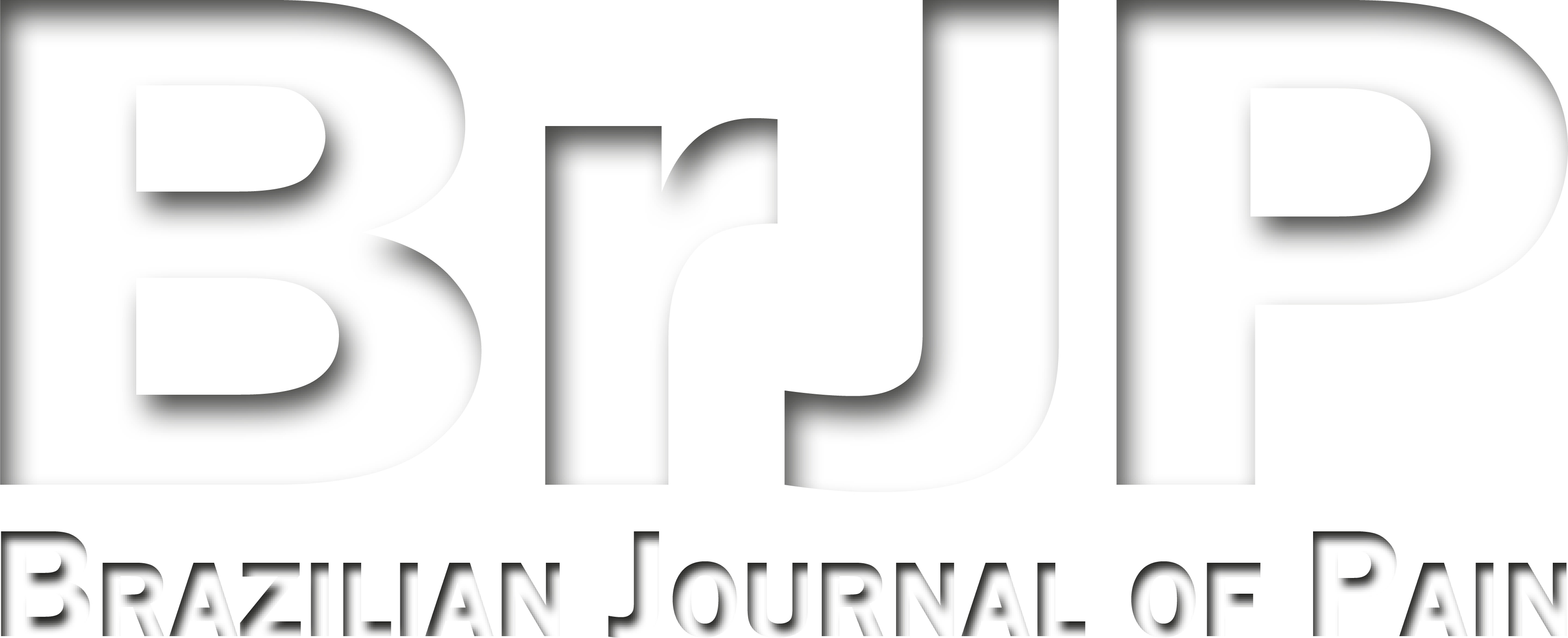Evaluation of the keratinocytes or fibroblasts culture supernatant in an inflammatory hyperalgesia model
Avaliação do sobrenadante da cultura de queratinócitos ou fibroblastos em modelo de hiperalgesia inflamatória
Cíntia Ávila Souza; Gilson Gonçalves dos Santos; Felipe Hertzing Farias; Eli Ávila Souza Júnior; Carlos Amilcar Parada
Abstract
Keywords
Resumo
Palavras-chave
References
Abbas AK, Janeway Jr CA. Immunology: improving on nature in the twenty-first century. Cell. 2000;100(1):129-38.
Dawes JM, Anderson DA, Bennett DL, Bevan S, McMahon SB. Inflammatory mediators and modulators of pain. Wall and Melzack's Textbook of Pain. 2013;6:48-67.
Levine JD, Taiwo Y. Inflammatory Pain. Textbook of Pain. 1994.
Carvalho MMMJ. O Sofrimento da dor em câncer. Introdução à psiconcologia. 2003:103-8p.
Messlinger K. What is a nociceptor?. Anaesthesist. 1997;46(2):142-53.
Besson JM. The complexity of physiopharmacologic aspects of pain. Drugs. 1997;53(Suppl.2):1-9.
Webster KE. Somaesthetic pathways. Br Med Bull. 1977;33(2):113-20.
Woolf CJ. Recent advances in the pathophysiology of acute pain. Br J Anaesth. 1989;63(2):139-46.
Stein C, Pflüger M, Yassouridis A, Hoelzl J, Lehrberger K, Welte C. No tolerance to peripheral morphine analgesia in presence of opioid expression in inflamed synovia. J Clin Invest. 1996;98(3):793-9.
Stein C, Gramsch C, Herz A. Intrinsic mechanisms of antinociception in inflammation: local opioid receptors and beta-endorphin. J Neurosci. 1990;10(4):1292-8.
Garcia JB, Cardoso MG, Dos-Santos MC. Opioids and the immune system: clinical relevance. Rev Bras Anestesiol. 2012;62(5):709-18.
Slominski AT, Zmijewski MA, Skobowiat C, Zbytek B, Slominski RM, Steketee JD. Sensing the environment: regulation of local and global homeostasis by the skin's neuroendocrine system. Adv Anat Embryol Cell Biol. 2012;212:v-155.
Vetter I, Kapitzke D, Hermanussen S, Monteith GR, Cabot PJ. The effects of pH on beta-endorphin and morphine inhibition of calcium transients in dorsal root ganglion neurons. J Pain. 2006;7(7):488-99.
Hollt V. Opioid peptide processing and receptor selectivity. Annu Rev Pharmacol Toxicol. 1986;26(1):59-77.
Nakanishi S, Inoue A, Kita T, Nakamura M, Chang AC, Cohen SN. Nucleotide sequence of cloned cDNA for bovine corticotropin-beta-lipotropin precursor. Nature. 1979;278(5703):423-7.
Sibinga NE, Goldstein A. Opioids peptides and opioid receptors in cell of the immune system. Annu Rev Immunol. 1988;6:219-49.
Wintzen M, Yaar M, Avila E, Vermeer BJ, Gilchrest BA. Keratinocytes produce b-endorphin and b-lipotropic hormone after stimulation by UV, IL-1a or phorbol esters. J Invest Dermatol. 1995;104:641.
Schauer E, Trautinger F, Köck A, Schwarz A, Bhardwaj R, Simon M. Proopiomelanocortin-derived peptides are synthesized and released by human keratinocytes. J Clin Invest. 1994;93(5):2258-62.
Bigliardi PL, Bigliardi-Qi M, Buechner S, Rufli T. Expression of mµ-opiate receptor in human epidermis and keratinocytes. J Invest Dermatol. 1998;111(2):297-301.
Lo HH, Tseng LF, Wei E, Li CH. Endorphin is a potent analgesic agent. Proc Natl Acad Sci. 1976;7(8):2895-8.
Slominski AT, Zmijewski MA, Zbytek B, Brozyna AA, Granese J, Pisarchik A. Regulated proenkephalin expression in human skin and cultured skin cells. J Invest Dermatol. 2011;131(3):613-22.
Bigliardi-Qi M, Sumanovski LT, Büchner S, Rufli T, Bigliardi PL. Mu-opiate receptor and beta-endorphin expression in nerve endings and keratinocytes in human skin. Dermatology. 2004;209(3):183-9.
Schaible HG. Pathophysiology of pain. Orthopade. 2006;36(1):8-16.
Schaible HG. Peripheral and central mechanisms of pain generation. Hand Exp Pharmacol. 2007:3-28.
Siderov J, Zalcberg JR. Prescribing opioids--a painful experience. Med J Aust. 1994;161(9):515-6.
Benyamin R, Trescot AM, Datta S, Buenaventura R, Adlaka R, Sehgal N. Opioid complications and side effects. Pain Physician. 2008;11(2 Suppl):S105-20.
Chou R, Turner JA, Devine EB, Hansen RN, Sullivan SD, Blazina I. The effectiveness and risks of long-term opioid therapy for chronic pain: a systematic review for a National Institutes of Health Pathways to Prevention Workshop. Ann Intern Med. 2015;162(14):276-86.
Eriksen J, Sjogren P, Bruera E, Ekholm O, Rasmussen NK. Critical issues on opioids in chronic non-cancer pain: an epidemiological study. Pain. 2006;125(1-2):172-9.
Vivancos GG, Verri Jr WA, Cunha TM, Schivo IR, Parada CA, Cunha FQ. An electronic pressure-meter nociception paw test for rats. Braz J Med Biol Res. 2004;37(3):391-9.
Rosland JH. The formalin test in mice: the influence of ambient temperature. Pain. 1991;45(2):211-6.
Henriques MG, Silva PM, Martins MA, Flores CA, Cunha FQ, Assreuy-Filho J. Mouse paw edema. A new model for inflammation?. Braz J Med Biol Res. 1987;20(2):243-9.
Bodnar RJ. Endogenous opiates and behavior: 2017. Peptides. 2020;124:170223.
Leong C, Neumann C, Ramasamy S, Rout B, Wee LY, Bigliardi-Qi M. Investigating endogenous µ-opioid receptors in human keratinocytes as pharmacological targets using novel fluorescent ligand. PloS one. 2017;12(12).
Li X, Zhu J, Tao Y, Tao K. Elevated endogenous opioids in obstructive jaundice: the possible skin mechanisms. Med Hypotheses. 2018;116:119-21.
Submitted date:
02/20/2020
Accepted date:
05/10/2020


